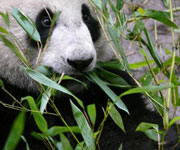Dja Faunal Reserve System
This is one of the largest and best-protected rainforests in Africa, with 90% of its area left undisturbed. Almost completely surrounded by the Dja River, which forms a natural boundary, the reserve is especially noted for its biodiversity and a wide variety of primates. It contains 107 mammal species, five of which are threatened. At the time of inscription on the World Heritage List, thousands of people were already living on the outskirts of the Reserve. The Dja Reserve is one of Africa's most species-rich rainforests.
Dja Faunal Reserve


UNESCO Criterion
Criterion (ix): The primary forest of the Dja Reserve is interesting for its diversity of species and its unique pristine condition. With its topographical diversity and its three biogeographical and geological influences, it has a rich and varied ecosystem that reflects the ecological evolution in progress in this type of environment. It belongs to the forest block considered to be the largest in Africa for the maintenance of biological diversity.
Criterion (x): The Dja Reserve is one of Africa's most species-rich rainforests. It includes the habitat of numerous remarkable animal and plant species, many of which are globally threatened. It has over 100 species of mammals, of which at least 14 primates (including several endangered species such as the western lowland gorilla, chimpanzee, white-collared mangabey, mandrill and drill). In addition, flagship species are found in the Reserve, such as the endangered forest elephant, and the nearly extinct African gray parrot, bongo and leopard.
Integrity
The Dja Reserve is one of Africa's largest and best-protected rainforests. At the time of World Heritage listing in 1987, 90% of the area was considered intact and human pressure was low. The Reserve has a population of Baka pygmies who live in a relatively traditional manner and confer a recognized cultural value to the site. Agriculture and commercial hunting are prohibited, but the Pygmies are allowed to hunt traditionally.
At the time of inscription on the World Heritage List, thousands of people were already living on the outskirts of the Reserve. Traditional agriculture remains their main economic activity and hunting their main source of animal protein supply. Mining and forestry prospecting were also underway in the region. No deposits have yet been discovered inside the property, but mining activities in the periphery could be harmful to its integrity.
The harvesting of timber remains a possibility, but the legal constraints and the inaccessibility of the region make it unlikely. The protection of the property against this type of activity as well as against other threats outside the boundaries of the property is essential.

Protection and management requirements
At the institutional level, the Dja Faunal Reserve is managed by the Dja Conservation Services (DCS), headed by a conservator. The management of the Reserve receives significant support from international cooperation partners of Cameroon through many projects. Sustained funding for the Dja Faunal Reserve is critical to move towards financial autonomy and ensure an adequate staff and management of resources.
At the operational level, the natural resources affected by high pressure have been identified and a local anti-poaching strategy has been developed. There are regular patrols in the forest and on the road in and around the Reserve, and a cooperative framework with the forestry operators for continuous monitoring of their concessions is in place. The strengthening of education and communication is vital to the management of the property, including increased awareness of local populations and the general public.
The DCS is strongly committed to this work, and the establishment of collaboration with 19 village vigilance committees is an important priority. The main areas of work include priority issues such as anti-poaching, collection of forest data, and the code of laws and procedures. A legal toolbox is also available and the optimal use of management effectiveness assessments to guide future management of the property, including its links with neighbouring areas is part of the process. Source
Want to read UNESCO Daily News Updates? Click Here!!!


